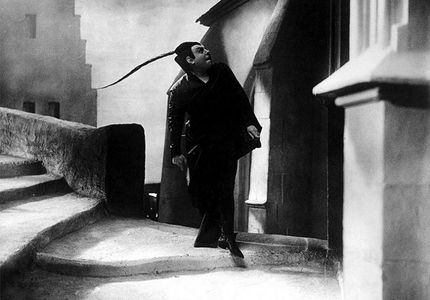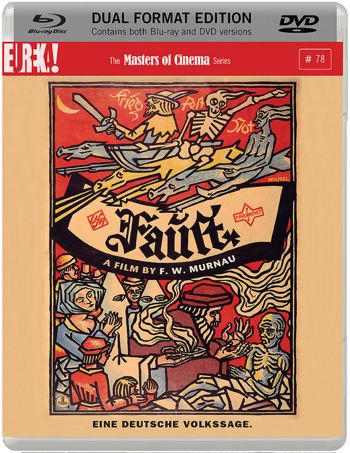Learning From The Masters Of Cinema: F.W. Murnau's FAUST - A GERMAN FOLK LEGEND

In today's cinematic marketplace, audiences have grown increasingly used to Hollywood fare dominating both domestic and international box offices. In the last few years we have even seen studios steer their biggest blockbusters increasingly towards overseas markets, with particular focus given to Asia. It is predominantly for this reason that we now get more remakes, reboots, sequels and franchise-building, in the hope of pushing familiar, pre-existing properties onto new audiences hungry for grand-scale spectacle rather than nuanced characterisation and intricate plotting. At the time of writing, every film in 2014's box office Top 10 was an adaptation of a pre-existing property. In fact the only film on the list that isn't a remake or sequel is Phil Lord and Chris Miller's The Lego Movie, based instead on the popular Danish building bricks.
When we cast our attentions back some 90 years, what is most surprising is that the populist film climate was much the same. While Germany was the great cinematic powerhouse of the period, rather than the US, the attitude was still to create large, spectacle-driven event pictures based on popular pre-existing texts that would appeal to a large global audience. In 1926, the German movie-making behemoth UFA (Universum Film Aktiengesellschaft) put two such projects into production. One was Fritz Lang's science fiction masterpiece, Metropolis - a financially risky vanity project conceived and developed by its director, and very much the Avatar of its day. The other film was Faust - Eine Deutsche Volkssage (Faust - A German Folk Legend), a production every bit as ambitious, unwieldy and ultimately influential.
Born out of German legend and folklore, Faust is the story of a frustrated academic who makes a pact with the devil, exchanging his soul for everlasting youth, knowledge and decadence. Most famously, the story was adapted twice for the stage, first by the British playwright Christopher Marlowe in 1604, and then even more ambitiously in German by Johann Wolfgang von Goethe. His two-part Faust forms the primary source for UFA's big screen adaptation, directed by the 37-year-old F.W. Murnau, in what would prove his last German language film.
From the outset, Faust was envisioned for a global audience, and producer Erich Pommer set about assembling an A-list international cast for the film. Emil Jannings, perhaps the biggest movie star in the world at the time, was pegged for the role of Satan - here dubbed Mephisto - reprising a role he had already played on stage. For the title role of Faust, the producers originally targeted American actor John Barrymore before settling on the relatively obscure Swedish performer Gosta Ekman. Likewise, Pommer and Murnau's efforts to land Lillian Gish for the pivotal female role of Gretchen were also scuppered when the actress insisted on bringing her own cinematographer to Germany. Unwilling to work with anyone but Carl Hoffmann, Murnau refused and so Gish walked. Perhaps frustrated by such prima donna behaviour, Murnau instead hired unknown Camilla Horn for the role, inadvertently launching a career that would see her work in Hollywood, England and Italy until her retirement in the 1950s.
There is much to say about these three central performances in Faust. Emil Jannings was at the height of his fame when he starred as Mephisto in his third collaboration with Murnau, following The Last Laugh and Tartuffe. His grotesque, over-the-top performance remains one of cinema's most vivid depictions of the devil. He is sinister and gargoyle-esque at times, but also flamboyant, effete and playful as he woos Faust into a life of debauchery and self-satisfaction. Two years later, Jannings would go on to win the Academy's very first Oscar for Best Actor, but the advent of the talkies saw the Austrian performer and his thick accent squeezed out of Hollywood, and he returned to Germany, where he appeared in a number of Nazi propaganda films.

Gosta Ekman was just 35 years old when he was cast in the role of Faust, and spent much of the film buried under heavy make-up so that he could portray aged as well as the youthful version of the character. Arguably, he performs better as the elderly Faust, desperate to help his community ravaged by the plague, disillusioned by science and faith, only to ultimately see the error of his dealings with the devil and make the ultimate sacrifice. All credit to the incredible make-up by Waldemar Jabs, as audiences would be forgiven for thinking Ekman was in fact twice his actual age.
It is surprising that young Camilla Horn ever wanted to act again following her experiences on Faust. Murnau was a director well-known for pushing his performers to the extreme, but his harsh treatment of Horn would be enough to make anyone reconsider their career choice. She was repeatedly left bound and chained for hours at a time, given no rest or refreshments between takes, in order to heighten her performance as a tortured and traumatised young woman. Apparently, Horn left the set battered and bleeding after being dragged around in chains during her scenes of trial and punishment towards the film's climax. But nevertheless spoke kindly of a director she was obviously infatuated with.
The real star of Faust, however, is F.W. Murnau himself, and the incredible visual artistry that he brings to the film. While still only a relatively young man, Murnau had received high praise for his work on Nosferatu, The Last Laugh and Tartuffe, and Hollywood was beckoning. Even before Faust, Murnau was being courted by the big American studios, and immediately after wrapping production on this film, he left for America, to work for William Fox on the much-celebrated Sunrise. In fact, when Faust premiered in Berlin in October 1926, both Murnau and Jannings were absent, with the director already hard at work on his next film and Jannings actually en route to Hollywood at the time.
Decades before the advent of digital effects, Murnau was pushing boundaries in terms of visual innovation that still impress and dazzle today. While they may no longer seem photo-realistic, his use of super-imposition, model work, camera movement and other visual storytelling techniques single out Faust as one of the great technical masterpieces of the silent era. During the incredibly entertaining and informative audio commentary from film critics Bill Krohn and David Ehrenstein that accompanies this new release from Masters of Cinema, dozens of films and filmmakers are name-checked as being influenced by and drawing directly from Murnau's grand gothic opus. Films such as The Thief of Bagdad and The Wizard of Oz, and everyone from James Whale to Steven Spielberg and Terry Gilliam, found something in Faust to inspire them.
The package also goes into great detail about Murnau's method of filming with two or more cameras in parallel simultaneously, and using multiple takes to create numerous different negatives of the film, which would then be shipped out to other countries and duplicated for mass release. Until recently, the original German cut of the film, which used Murnau's preferred takes of each shot in almost every case, had gone completely unseen outside of Germany. Now lovingly restored and remastered by the Frederich-Wilhelm-Murnau-Stiftung (responsible for gorgeous new restorations of numerous German classics by Murnau, Lang and others), the full original German version of Faust is now available on Blu-ray for the first time.
Masters of Cinema port everything over from their 2006 DVD release of Faust, including a fascinating anecdotal video piece by Tony Rayns, a video comparison of the different versions of the film (showcasing how some foreign cuts of the film include bloopers and outtakes in addition to alternative takes of almost every scene), and the German-language documentary The Language of Shadows about the making of the film. As well as both Timothy Brock's orchestral score and a specially commissioned harp score from Stan Ambrose, this new Blu-ray release also boasts a third score, from pianist Javier Perez de Azpeitia, in addition to a 44-page booklet featuring writing by Peter Spooner and Eric Rohmer.
Praise for the cinematic contributions of F.W. Murnau too often focus on his seminal vampire flick Nosferatu and Oscar-winning Hollywood debut, Sunrise. While there is no denying that both those films are undisputed classics from one of cinema's first great master craftsmen, the rest of his oeuvre is every bit as technically and visually impressive. Faust stands as not only one of the great works of medieval fantasy from Germany's silent era, and cinema's finest ever adaptation of the classic Faust story, but also as one of the most effective and influential horror films ever made, which can now be experienced in more loving detail than ever before.
Faust - A German Folk Legend is released in the UK on dual-format Blu-ray/DVD by Eureka Entertainment's Masters of Cinema series today.

Do you feel this content is inappropriate or infringes upon your rights? Click here to report it, or see our DMCA policy.






